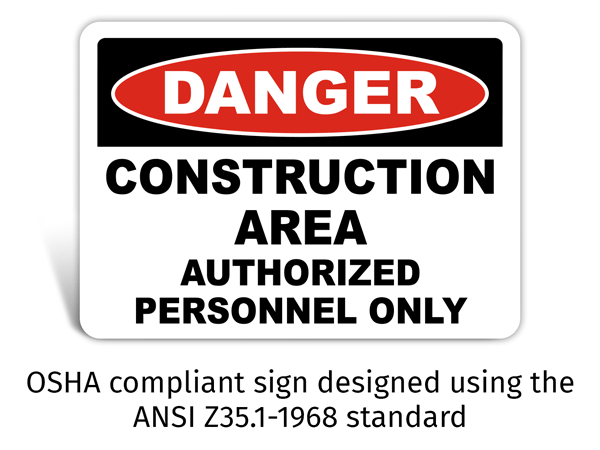What are safety sign requirements?
The basic purpose of a safety sign is to alert someone to a policy or potential hazard with enough time to take action and ensure their own safety.
With that as a goal, basic requirements of safety signs should be displaying elements that gain the attention of onlookers in a clear and concise way.
This could be fulfilled by the use of bold colors, clear messages, or universally understood imagery.
Specific safety sign requirements will vary based on a number of factors, including what kind of workplace standards the signage needs to comply with for safety.
Other factors could be minimum necessary viewing distance of the message, the potential hazard or policy that they alert persons to, and policies that guide industry best practices.
The Occupational Safety and Health Administration (OSHA) sets and enforces safety standards for most workplaces in the country, and has developed specific definitions for the types of safety signage that should be used in the workplace.

In the early 1970’s, OSHA adopted the American National Standards Institute’s (ANSI) Z35.1-1968 standard for the design of safety signs – the design we now think of when imagining OSHA safety signs.
This ANSI standard defined the layout of danger signs, caution signs, radiation warning signs, safety instruction signs, exit signs, directional signs, notice signs, and the slow moving vehicle emblem.
In the standard, the definitions of danger signs, caution signs, safety instruction signs, directional signs, and notice signs were also explained.
ANSI has updated their standards for the required design of accident preventions signs (safety signs), and OSHA has recently incorporated these standards.
What is the ANSI format for safety signs?
ANSI safety sign formats are based on the ANSI Z535-2011 standard. This standard has three important elements, including a safety header, images, and the sign legend. Learn more here.
What is the OSHA format for safety signs?
OSHA formats for safety signs include specific use of safety headers, colors, and sign legends. These are OSHA standards and have come to incorporate the ANSI Z535-2011 standard. Learn more here.
also see:
SafetySign.com does not recommend or specify the use of a specific safety sign because it does not have knowledge of the hazard(s) our customers are identifying. It is the customer’s sole responsibility to identify the hazard(s) that may be present and select one or more signs (stock or custom) that accurately identify their specific hazard(s) and complies with any applicable federal, state or local laws or regulations, any worksite specific rules or regulations and/or any applicable safety standards (including, without limitation, ANSI and/or OSHA standards). SafetySign.com disclaims any and all liability (excluding liability for our Product Warranty contained in our Terms and Conditions) for any sign selected by a customer and shall not be responsible for any personal injury or property damage resulting from the use of signs purchased from it or for the independent interpretation made of any applicable federal, state or local laws or regulations, any worksite specific rules or regulations, and/or any applicable safety standards (including, without limitation, ANSI and/or OSHA standards). Customer shall indemnify and hold SafetySign.com and its corporate parent and its officers, directors and affiliates harmless from and against any and all claims, loss or expense (including attorneys’ fees) arising from or related to the purchase and use by customer or any third party of any sign purchased by customer from SafetySign.com.
